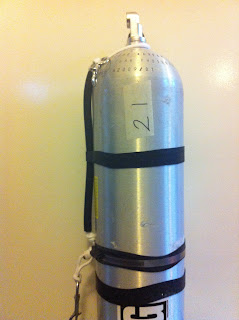This
article is designed to allow the reader to correctly mark up their stage/decompression
cylinder. Due to only owning a certain
quantity of cylinders, I have decided to use masking tape to mark mine however
if diving using ‘standard gasses’ all the time then permanent stickers could be
used such as those made by Dive Signs.
Overview
One of the
biggest issues concerning any diver (technical or otherwise) using Nitrox is
breathing the wrong gas as it will almost certainly lead to oxygen toxicity (as
the maximum operating depth (MOD) has been exceeded) leading to death. To reduce this risk we can do a number of
things including analysing the gas upon filling AND re-analysing PRIOR to
diving (if the cylinder has been left unattended for a period of time) and
ensuring the cylinder is marked up correctly.
The stage/decompression cylinder must:
1. Be free
of all unnecessary clutter.
2. Have
markings that are clear and easy to read.
3. Have the
MOD clearly marked in large numbers on BOTH sides of the cylinders (MOD or m is
optional*) where it’s visible to the divers buddy.
4. Have
analysis tape on the shoulder of the cylinder including percentage (to the
decimal), MOD, pressure, date and initials/signature of the analyser.
*To the
untrained, the number could be the percentage or the MOD. For example if we look at probably the 2 most
common numbers you may see on the side of a cylinder, 50 and 21, 50 could be 50%
with an MOD of 21m or 50m with a Nitrox mix of 26%. 21
could be air with an MOD of 50m or 21m with a Nitrox mix of 50%.
Why do we mark
the MOD rather than the percentage? Surely
you want to know what gas you’re breathing?
This is correct however the last thing I want my brain to do when I have
a number of cylinders to choose from is to try and work out which one I need by
calculating the MOD in my head. All I need
to do is look at the cylinder and I automatically can see which one I need to
breathe from next.
Analysing the gas
This
article is not designed to teach you how to analyse Nitrox or work out an MOD,
however it will be briefly covered. If
you wish to learn more about this then please feel free to contact me here.

Using my
analyser I find the Nitrox percentage in my cylinder
(instructions here).
Using Daltons
Triangle I am going to work out the MOD for my gas mix.
In this
example:
1.6 ÷ 0.508
= 3.15 BAR (abs) = 21m
(Most agencies tend to use a PO2 of 1.4 for the dive phase and 1.6 for the
decompression phase however check with your agency standards first)
Marking
Using masking (or gas analysis) tape I then record the details as mentioned below:
1. Percentage (to the decimal*).
1. Percentage (to the decimal*).
2. MOD.
3.
Pressure.
4. Date.
5. Initials/signature
of the analyser.
*The reason
for displaying the decimal is to prove it’s been analysed, rather than just
writing down what you want from the filling station.
Finally as
mentioned in the second paragraph the MOD is clearly marked in large numbers on
BOTH sides of the cylinders.
No
additional information is required or needed on the cylinder. The only exception is if you decide to use
100% oxygen then you may wish to have an oxygen sticker down the side instead
of/as well as the MOD (6m).
If you wish
to have your initials on your cylinder, they can be placed on the on lower end
of the cylinder so they do not interfere with the MOD or cause confusion.
Well done, your stage/decompression cylinder is now correctly marked up for use. If you don’t know how to correctly fit a rigging kit click here otherwise next we need to ensure the stage/decompression regulators are set up correctly (here).
EDIT. 22 DECEMBER 2018
Since writing this article I now use different tape to label my cylinders as it stands out much better. I use Duck tape (in this case white, but silver or yellow would work) and then write on it with permanent marker. Lastly I place a strip of wide sellotape over the top to lock the writing in, as when wet, if friction is applied the permanent marker can, and will rub off. And if you look at the pictures you can see a clear difference, the markings are much easier to spot.
The boring bit!
All opinions
expressed in my articles are my own and may differ to other instructor’s and
agency guidelines; by no means are they wrong and I would not wish to disrepute
any of them. This article is for
information only and should not replace proper training.
Safe diving!
Timothy Gort
BSAC, PADI
& SDI/TDI diver trainingl Mob: 07968148261 l Email: tim@rectotec.co.uk l








No comments:
Post a Comment